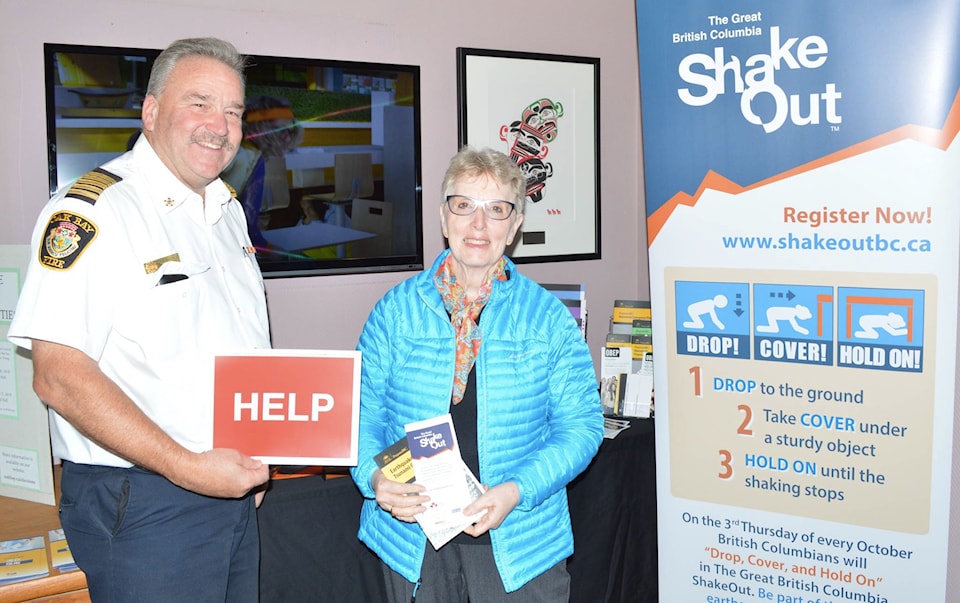When the clock strikes 10:18 a.m. tomorrow, thousands of Vancouver Islanders will practice what to do in the event of an earthquake.
According to Oak Bay Fire Chief Dave Cockle, who’s also the B.C. Earthquake Alliance’s president and chair, more than 730,000 British Columbians have already registered to take part in the annual Great British Columbia ShakeOut.
And with thousands of residents still registering every day, Cockle expects over 900,000 people to take part in the B.C.-wide, one-and-a-half-minute drill.
“I’d love to see it get to a million [people] because that’s a quarter of the B.C. population,” said Cockle.
“This event is important because, as beautiful as the area that we live in is, the area has earthquake risk, and the best practice in the event of an earthquake is to drop, cover and hold on,” he continued. “It’s about knowing what to do immediately in the time that it happens, and then move forward.”
“Shake out, don’t freak out,” he added.
Basic preparations include purchasing or preparing an emergency survival kit and developing plans for family or fellow employees about what to do should disaster strike.
“Part of what we’re trying to do is to get people engaged into making an emergency kit or checking their existing kit and also practising their drills,” said Karen Lindsay, City of Nanaimo emergency program manager. “They can practice it at work, through discussions. They can practice it at home with their families and loved ones by talking it, having people become familiar with the kit and registering either their family or business.”
Vancouver Island is in an earthquake zone that can generate powerful seismic events with great destructive potential that can disrupt electrical power and communication networks, water and sewerage system and transportation infrastructure that can make roads impassable for emergency responders. People are advised to have emergency supplies, such as food, water, clothing and other basics to get through at least the first 72 hours or longer following a major seismic event.
Some communities across the Island are scheduling activities catered specifically to their needs.
The Campbell River-area Strathcona Regional District is encouraging the community to participate in its annual reminder that residents live below a series of dams holding back a lot of water.
“There’s a risk of failure at the John Hart and Strathcona dams after a major earthquake, and that could mean flooding in low-lying areas, including the downtown area,” said Stephen Watson of BC Hydro. “BC Hydro has plans to seismically upgrade these dams, but community members should be prepared to get out of the potential flood zone after an earthquake.”
“(Our) community exercise will encourage residents to take action to help themselves,” says Shaun Koopman, protective services coordinator with the Strathcona Regional District. “People need to know whether they can get outside the flood zone after the shaking stops. Get ready to practise your evacuation plan so that you know what will work and what you need to change to keep yourself safe in the event of a major earthquake.”
According to the B.C. Earthquake Alliance (BCEA), which has been organizing the ShakeOut drill since January 2010, official rescue teams that have been dispatched to the scene of earthquakes and other disasters around the world continue to advocate use of the internationally recognized “drop, cover and hold on” protocol.
As the name suggests, it involves dropping to the ground, taking cover by getting under a sturdy desk or table, and holding on to it until the shaking stops.
If there isn’t a table or desk near you, the BCEA advises you to drop to the ground in an inside corner of the building and cover your head and neck with your hands and arms. Do not try to run to another room just to get under a table.
Individuals and businesses interested in taking part in the Oct. 18 drill are encouraged to register online at shakeoutbc.ca, where more information, videos and resources on how to be better prepared for an earthquake can be found.
Or check with your local municipality or regional district.
